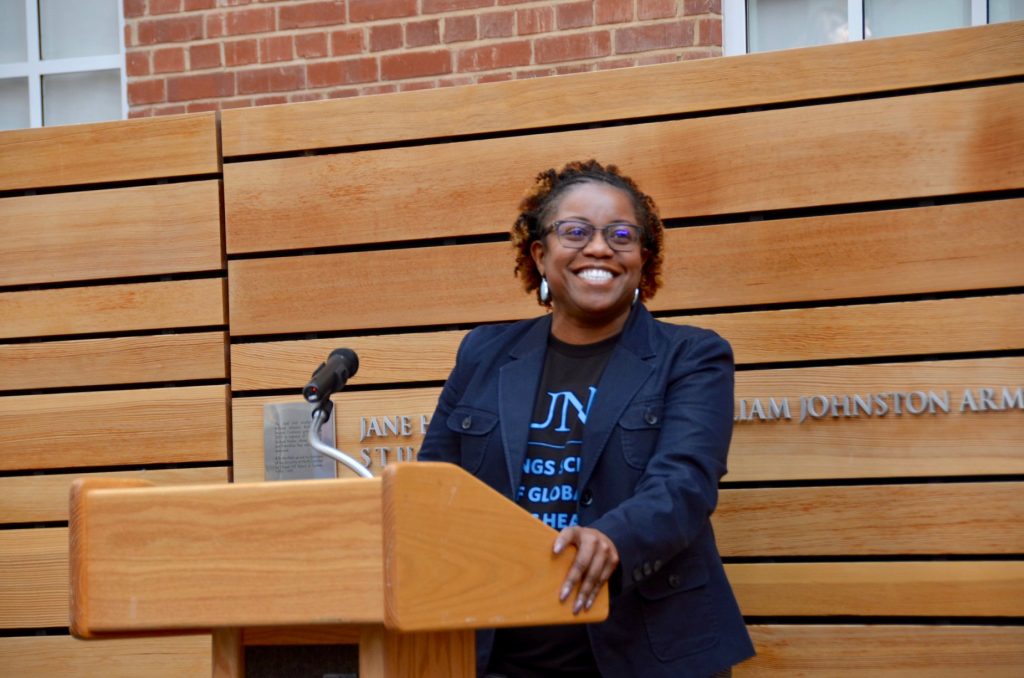Inclusive Excellence Through the Years
Creating a diverse, inclusive environment is rarely simple and never fast. Gillings has been working toward fostering an inclusive environment since it was established in 1940. Read on to find out more about major initiatives to achieve inclusive excellence through the years.
2018 – present: Creating an inclusive environment for the future of public health

Kauline Cipriani, PhD, speaks at the Gillings School’s Diversity Preview Day.
2019: Coordinated efforts toward achieving inclusive excellence accelerate:
- Inclusive Excellence Council formed to steer efforts toward meeting the goals set forth in the Inclusive Excellence Action Plan.
- Inaugural cohort of the EQUITY concentration begins Gillings MPH program.
- Yesenia Merino, PhD, MPH joins Gillings as the director of inclusive excellence training and education.
- Gillings faculty, staff and students meet to discuss priorities toward achieving inclusive excellence and start to develop the Inclusive Excellence Action Plan.
2018: Several important strides were made to shift from an assessment of needs at Gillings toward implementing changes at the School to meet the evolving needs of the public health workforce:
- Kauline Cipriani, PhD joins Gillings to lead our inclusion efforts as assistant dean for inclusive excellence and associate professor of public health leadership.
- Approval of a new concentration within the Gillings MPH – Health Equity, Social Justice and Human Rights (EQUITY).
2011 – 2017: Renewed focus on fostering inclusive excellence
2015: Students develop a first generation graduate student initiative at Gillings that evolves into the Carolina Grad Student F1RSTS program.
2013: Admissions practices are reviewed across departments; new, promising practices are adopted.
2012: Ms. Trinnette Cooper, MPH, is hired as coordinator for diversity outreach programs and recruitment; summer programs are updated.
2011: The School’s Diversity and Inclusion Task Force offers its recommendations for strengthening diversity and inclusion at the Gillings School. Faculty, staff and students start putting key recommendations from the blueprint into action:
- Rumay Alexander, EdD, RN, is appointed diversity champion for the Gillings School. In this role, she provides guidance and support to faculty, staff and students from across the School on creating a welcoming, inclusive and respectful environment for all;
- Course in LGBT health is developed and launched;
- Dean’s Council posts its diversity statement;
- We revise and broadly circulate our equal opportunity statement.
1990 – 2010: Initiatives attempt to keep inclusive momentum going
2010: Diversity and Inclusion are named as one of four priority foci in SPH2020, our School’s strategic plan.
2005: Dr. Barbara K. Rimer is named dean and makes overcoming health disparities a top priority for the School.
2001: Interdisciplinary Certificate in Health Disparities launched.
1997: The School’s Program on Ethnicity, Culture and Health Outcomes is launched.
1994: The School’s Minority Health Project is started.
1965 – 1989: Bringing the health of marginalized populations to the forefront

Students attend an early Minority Health Conference.
1980s: With effective advocacy on the part of students, courses established on women’s health, minority health.
1985: The U.S. Department of Health and Human Services releases its first task force report on Black and minority health. The School gets research funding to study critical minority health issues, including funding for cancer prevention and control as well as for cardiovascular health.
1977: The School’s Minority Student Caucus organizes the first Minority Health Conference. Over 1000 researchers and practitioners continue to participate each year in this student-led, national conference.
1971: The Black Student Caucus (now the Minority Student Caucus) is launched by students. Key faculty members support their efforts. The Caucus still helps UNC Gillings sustain a diverse, inclusive environment and research and outreach focus on health disparities.
1968: South African native Dr. Guy Steuart joins SPH faculty as chair of Health Education. He brings with him the Action-Oriented Community Diagnosis methodology, an interdisciplinary approach to gaining a nuanced understanding of the dynamics, resources and problems of communities and how these factors affect the health of individuals who live in them. This methodology is used to this day as an ethical way to work with vulnerable communities.
1940 – 1964: Establishing an activist-oriented school

The first cohort of health education students at North Carolina Negroes College (North Carolina Central University). Dr. Lucy Morgan stands second from left.
1964: William A. Darity and Edward V. Ellis become the first African-Americans to earn doctoral degrees (in health education) from the School — and from the UNC Graduate School.
1960s: School faculty and students organize sit-ins and marches advocating desegregation and civil rights. Numbers of African-American and international students grow; their presence and advocacy are a catalyst for change.
1959: Dr. John Cassel, a South African expat who left his country because of its apartheid policies, becomes the first chair of the School’s new Department of Epidemiology. Other South African public health luminaries join the faculty at our School.
1955: Health education training program focused on the needs of American Indians established in partnership with the U.S. Public Health Service.
1940s-50s: Field training programs created across the U.S. to close racial gaps in health outcomes
1950s: Students from around the world earn graduate degrees from our programs, including students from Burma, Formosa, Egypt, Guatemala, Iran, India, Israel, Nicaragua, Paraguay and the Phillipines.
1945: Joint public health training program established with North Carolina Central University (then the North Carolina Negroes College). Close partnerships with NCCU continue to this day. At a time when the South was segregated, people in this School were not intimidated by prevailing customs. That spirit is part of our school’s DNA.
1940: UNC School of Public Health established
